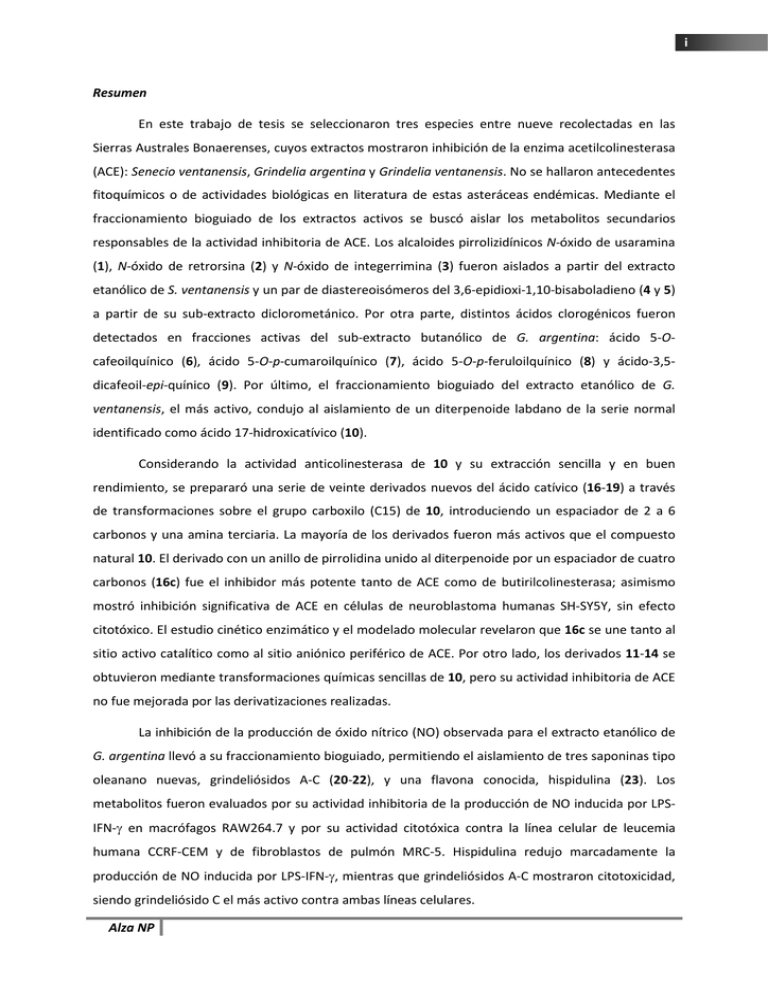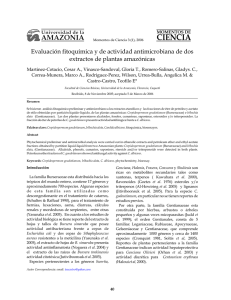Tesis Alza, N. texto parcial.pdf
Anuncio

i Resumen En este trabajo de tesis se seleccionaron tres especies entre nueve recolectadas en las Sierras Australes Bonaerenses, cuyos extractos mostraron inhibición de la enzima acetilcolinesterasa (ACE): Senecio ventanensis, Grindelia argentina y Grindelia ventanensis. No se hallaron antecedentes fitoquímicos o de actividades biológicas en literatura de estas asteráceas endémicas. Mediante el fraccionamiento bioguiado de los extractos activos se buscó aislar los metabolitos secundarios responsables de la actividad inhibitoria de ACE. Los alcaloides pirrolizidínicos N-óxido de usaramina (1), N-óxido de retrorsina (2) y N-óxido de integerrimina (3) fueron aislados a partir del extracto etanólico de S. ventanensis y un par de diastereoisómeros del 3,6-epidioxi-1,10-bisaboladieno (4 y 5) a partir de su sub-extracto diclorometánico. Por otra parte, distintos ácidos clorogénicos fueron detectados en fracciones activas del sub-extracto butanólico de G. argentina: ácido 5-Ocafeoilquínico (6), ácido 5-O-p-cumaroilquínico (7), ácido 5-O-p-feruloilquínico (8) y ácido-3,5dicafeoil-epi-quínico (9). Por último, el fraccionamiento bioguiado del extracto etanólico de G. ventanensis, el más activo, condujo al aislamiento de un diterpenoide labdano de la serie normal identificado como ácido 17-hidroxicatívico (10). Considerando la actividad anticolinesterasa de 10 y su extracción sencilla y en buen rendimiento, se prepararó una serie de veinte derivados nuevos del ácido catívico (16-19) a través de transformaciones sobre el grupo carboxilo (C15) de 10, introduciendo un espaciador de 2 a 6 carbonos y una amina terciaria. La mayoría de los derivados fueron más activos que el compuesto natural 10. El derivado con un anillo de pirrolidina unido al diterpenoide por un espaciador de cuatro carbonos (16c) fue el inhibidor más potente tanto de ACE como de butirilcolinesterasa; asimismo mostró inhibición significativa de ACE en células de neuroblastoma humanas SH-SY5Y, sin efecto citotóxico. El estudio cinético enzimático y el modelado molecular revelaron que 16c se une tanto al sitio activo catalítico como al sitio aniónico periférico de ACE. Por otro lado, los derivados 11-14 se obtuvieron mediante transformaciones químicas sencillas de 10, pero su actividad inhibitoria de ACE no fue mejorada por las derivatizaciones realizadas. La inhibición de la producción de óxido nítrico (NO) observada para el extracto etanólico de G. argentina llevó a su fraccionamiento bioguiado, permitiendo el aislamiento de tres saponinas tipo oleanano nuevas, grindeliósidos A-C (20-22), y una flavona conocida, hispidulina (23). Los metabolitos fueron evaluados por su actividad inhibitoria de la producción de NO inducida por LPSIFN-γ en macrófagos RAW264.7 y por su actividad citotóxica contra la línea celular de leucemia humana CCRF-CEM y de fibroblastos de pulmón MRC-5. Hispidulina redujo marcadamente la producción de NO inducida por LPS-IFN-γ, mientras que grindeliósidos A-C mostraron citotoxicidad, siendo grindeliósido C el más activo contra ambas líneas celulares. Alza NP ii Abstract In this work three of nine species collected in the Sierras Australes Bonaerenses were selected because of the acetylcholinesterase (AChE) inhibition showed by their extracts: Senecio ventanensis, Grindelia argentina y Grindelia ventanensis. There is no phytochemical or biological activities previous record in the literature for these endemic species of the Asteraceae family. The isolation of the metabolites responsible of the activity was conducted by a bioassay guided fractionation. The pyrrolizidine alkaloids usaramine N-oxide (1), retrorsine N-oxide (2) and integerrimine N-oxide (3) were isolated from the ethanolic extract of S. ventanensis and a pair of distereoisomers of 3,6-epidioxy-1,10-bisaboladiene (4 and 5) from its dichloromethane sub-extract. Additionally, different chlorogenic acids were detected in the active fractions of G. argentina butanolic sub-extract: 5-O-caffeoylquinic acid (6), 5-O-p-coumaroylquinic acid (7), 5-O-feruloylquinic acid (8), and 3,5-dicaffeoyl-epi-quinic acid (9). Finally, the bioactivity guided fractionation of the ethanolic extract of G. ventanensis, the most active one, led us to isolate a normal labdane diterpenoid identified as 17-hydroxycativic acid (10). Taking into account the anticholinesterase activity of 10 and its easy extraction in good yield, a set of twenty new cativic acid derivatives (16-19) was prepared from 10 through transformations on the carboxylic group at C15, introducing a C2-C6 linker and a tertiary amine group. Most of the tested compounds were better AChE and butyrylcholinesterase (BChE) inhibitors than the natural diterpenoid 10. The derivative with a four carbon spacer and a pyrrolidine moiety (16c) was the most potent AChE and BChE inhibitor; in addition it exhibited significant inhibition of AChE activity in SHSY5Y human neuroblastoma cells and was non-cytotoxic. Enzyme kinetic studies and molecular modeling revealed that 16c targeted both the catalytic active site and the peripheral anionic site of AChE. On the other hand, derivatives 11-14 were obtained through simple structural modifications of 10, but their AChE inhibitory activity was not improved by the derivatizations. The inhibitory activity of nitric oxide (NO) production of the ethanolic extract of G. argentina prompted us to isolate three new oleanane-type saponins, grindeliosides A-C (20-22), and a known flavone, hispidulin (23). The isolated compounds were evaluated for their inhibitory activities against LPS/IFN-γ induced NO production in RAW 264.7 macrophages and for their cytotoxic activities against the human leukemic cell line CCRF-CEM and MRC-5 lung fibroblasts. Hispidulin markedly reduced LPS/IFN- γ induced NO production while grindeliosides A–C were found to be cytotoxic, with grindelioside Alza NP C being the most active against both cell lines. CHEMISTRY & BIODIVERSITY – Vol. 11 (2014) 321 72 h, a freshly prepared XTT soln. (5 ml of XTT soln., plus 100 ml of electron coupling reagent) was added and analyzed after another 1.5 (MRC-5 cells) or 4 h (CCRF-CEM cells) using a Victor2 1420 multilabel counter (PerkinElmer Life Sciences, Waltham, MA, USA). Vinblastine served as positive control (0.01 mm). The IC50 values were determined using SigmaPlot 12.0 (Systat Software Inc., Chicago, IL, USA) and the four-parameter logistic curve. At least five different concentrations and two different cell passages each tested in three independent wells were used. REFERENCES [1] J. J. Hoffmann, S. D. Jolad, B. N. Timmermann, R. B. Bates, F. A. Camout, Phytochemistry 1988, 27, 493. [2] S. D. Jolad, B. N. Timmermann, J. J. Hoffmann, R. B. Bates, T. J. Siahaan, Phytochemistry 1987, 26, 483. [3] B. N. Timmermann, J. J. Hoffmann, S. D. Jolad, R. B. Bates, T. J. Siahaan, Phytochemistry 1986, 25, 723. [4] B. N. Timmermann, J. J. Hoffmann, S. D. Jolad, R. B. Bates, T. J. Siahaan, Phytochemistry 1986, 25, 1389. [5] B. N. Timmermann, J. J. Hoffmann, S. D. Jolad, K. H. Schram, Phytochemistry 1985, 24, 1031. [6] B. N. Timmermann, D. J. Luzbetak, J. J. Hoffmann, S. D. Jolad, K. H. Schram, R. B. Bates, R. E. Klenck, Phytochemistry 1983, 22, 523. [7] B. N. Timmermann, J. J. Hoffmann, S. D. Jolad, R. B. Bates, T. J. Siahaan, Phytochemistry 1987, 26, 467. [8] A. A. Mahmoud, A. A. Ahmed, T. Tanaka, M. Iinuma, J. Nat. Prod. 2000, 63, 378. [9] A. A. Ahmed, A. A. Mahmoud, U. M. Ahmed, A. A. El-Bassuony, M. H. Abd El-Razk, P. W. Pare, J. Karchesy, J. Nat. Prod. 2001, 64, 1365. [10] M. I. Ybarra, S. Popich, S. A. Borkosky, Y. Asakawa, A. Bardón, J. Nat. Prod. 2005, 68, 554. [11] A. M. El-Shamy, S. S. El-Hawary, A. O. El-Shabrawy, H. M. El-Hefnawy, H. Glasl, J. Essent. Oil Res. 2000, 12, 631. [12] M. N. Newton, L. Ariza Espinar, N. R. Grossi, M. P. Zunino, D. M. Maestri, J. A. Zygadlo, Planta Med. 1998, 64, 470. [13] G. Kaltenbach, M. Schfer, O. Schimmer, J. Essent. Oil Res. 1993, 5, 107. [14] D. Fraternale, L. Giamperi, A. Bucchini, D. Ricci, Fitoterapia 2007, 78, 443. [15] L. Krenn, E. Wollenweber, K. Steyrleuthner, M. F. Melzig, Fitoterapia 2009, 80, 267. [16] S. Kreutzer, O. Schimmer, R. Waibel, Planta Med. 1990, 56, 392. [17] K. Ghedira, P. Goetz, R. Le Jeune, Phytothérapie 2010, 8, 314. [18] A. F. Rose, K. C. Jones, W. F. Haddon, D. L. Dreyer, Phytochemistry 1981, 20, 2249. [19] ESCOP Monographs 2009, 2nd edn., Supplement, ESCOP and Thieme Ed. [20] V. D. La, F. Lazzarin, D. Ricci, D. Fraternale, S. Genovese, F. Epifano, D. Grenier, Phytother. Res. 2010, 24, 1687. [21] R. Pavela, Ind. Crops Prod. 2010, 32, 213. [22] N. Verma, S. K. Tripathi, D. Sahu, H. R. Das, R. H. Das, Mol. Cell. Biochem. 2010, 336, 127. [23] L. Deble, A. Oliveira-Deble, Bonplandia 2010, 19, 47. [24] T. Hase, K. Ohtani, R. Kasai, K. Yamasaki, C. Picheansoonthon, Phytochemistry 1995, 40, 287. [25] Y. Su, K. Koike, T. Nikaido, J. Liu, J. Zheng, D. Guo, J. Nat. Prod. 2003, 66, 1593. [26] J. Eskander, C. Lavaud, S. M. Abdel-khalik, H. S. M. Soliman, I. I. Mahmoud, C. Long, J. Nat. Prod. 2005, 68, 832. [27] G. Reznicek, O. Susman, K. Bçhm, Sci. Pharm. 1993, 61, 35. [28] A. S. Perlin, B. Casu, Tetrahedron Lett. 1969, 34, 2921. [29] Y. Su, K. Koike, D. Guo, T. Satou, J. Liu, J. Zheng, T. Nikaido, Tetrahedron 2001, 57, 6721. [30] E. Angaard, Lancet 1994, 343, 1199. [31] M. Lechner, P. Lirk, J. Rieder, Cancer Biol. 2005, 15, 277. [32] L. He, Y. Wu, L. Lin, J. Wang, Y. Wu, Y. Chen, Z. Yi, M. Liu, X. Pang, Cancer Sci. 2011, 102, 219. 322 CHEMISTRY & BIODIVERSITY – Vol. 11 (2014) [33] Y. Yin, F. Gong, X. Wu, Y. Sun, Y. Li, T. Chen, X. Xu, J. Ethnopharmacol. 2008, 120, 1. [34] M. Clavin, S. Gorzalczany, A. Macho, E. Muñoz, G. Ferraro, C. Acevedo, V. Martino, J. Ethnopharmacol. 2007, 112, 585. [35] F. Conforti, F. Menechini, Curr. Med. Chem. 2011, 18, 1137. [36] F. Conforti, D. Rigano, F. Menechini, M. R. Loizzo, F. Senatore, Fitoterapia 2009, 80, 62. [37] C. M. Lin, S. T. Huang, Y. C. Liang, M. S. Lin, C. M. Shih, Y. C. Chang, T. Y. Chen, T. Y. Chen, Planta Med. 2005, 71, 748. [38] H. K. Kim, B. S. Cheon, Y. H. Kim, S. Y. Kim, H. P. Kim, Biochem. Pharmacol. 1999, 58, 759. [39] M. Blunder, X. Liu, O. Kunert, A. Schinkovitz, C. Schmiderer, J. Novak, R. Bauer, Planta Med. 2013, in press. [40] B. Rinner, N. Kretschmer, H. Knausz, A. Mayer, H. Boechzelt, X.-J. Hao, G. Heubl, T. Efferth, H. Schaider, R. Bauer, J. Ethnopharmacol. 2010, 129, 182. Received June 14, 2013
